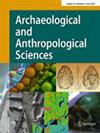Due to the scarcity of stratified and well-dated archaeological horizons, diachronic as well as spatial patterns of Pleistocene lithic traditions are not very well understood in Arabia. To contribute to this topic, we present new archaeological, sedimentological and chronological data from archaeological horizon II (AH II), the stratigraphically youngest Middle Palaeolithic assemblage at Jebel Faya, Emirate of Sharjah, United Arab Emirates. Results of optically stimulated luminescence dating reveal that AH II was deposited about 80 ka ago at the end of Marine Isotope Stage 5 (MIS 5). The lithic assemblage shows a preference for elongated flakes and blades produced predominantly by bidirectional methods, both Levallois and non-Levallois. The few tools feature simple retouch often forming denticulated edges. Contemporaneous assemblages from Arabia are rare and show distinct technological characteristics, including a preference for the production of flakes with ovoid and triangular morphologies from centripetal as well as unidirectional convergent and bidirectional convergent Levallois methods. These differences indicate that traditions in the production of stone tool blanks follow distinct trajectories north and south of the Rub al-Khali desert at the termination of the MIS 5 humid period.


